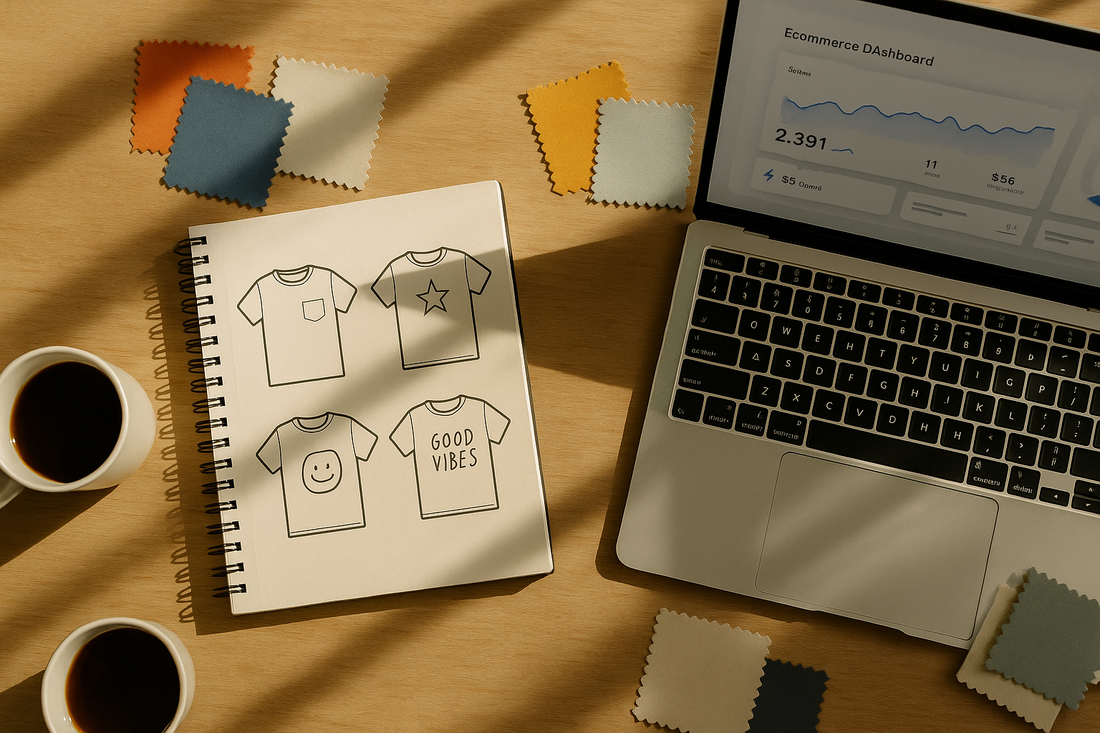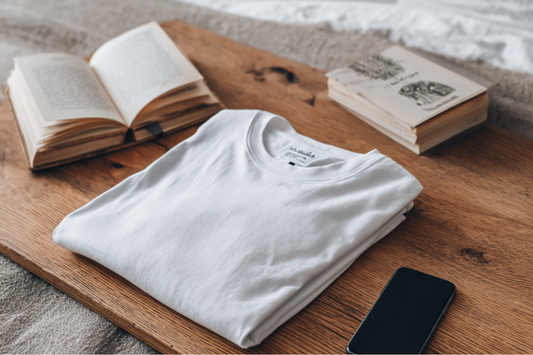
Starting Your Own T-Shirt Brand: A Step-by-Step Guide
The T-shirt industry is booming, with global market value expected to reach $185 billion by 2025. But here's the reality: success in the T-shirt business isn't just about great designs—it's about strategic planning, smart execution, and understanding your market deeply. Whether you're a creative designer or an aspiring entrepreneur, starting your own T-shirt brand can be incredibly rewarding with the right approach.
This comprehensive guide will walk you through every essential step, from initial concept to profitable business, helping you avoid common pitfalls and accelerate your path to success.
Step 1: Define Your Brand Identity and Niche
Find Your Unique Position
The T-shirt market is saturated, so standing out requires a clear brand identity and specific niche focus.
Popular Niche Categories:
- Lifestyle Brands: Minimalist, premium basics for everyday wear
- Statement Apparel: Bold graphics, political messages, humor
- Hobby/Interest Based: Gaming, fitness, music, specific communities
- Local Pride: City-specific, regional themes, local landmarks
- Eco-Conscious: Sustainable materials, ethical production
Develop Your Brand Story
Your brand story should answer:
- What problem does your brand solve?
- What values do you represent?
- Who is your ideal customer?
- What makes you different from competitors?
Example: "We create premium, ethically-made T-shirts for conscious consumers who value quality and sustainability over fast fashion."
Create Your Brand Elements
- Brand Name: Memorable, easy to spell, available domain
- Logo Design: Simple, scalable, works in various applications
- Color Palette: 2-3 primary colors that reflect your brand personality
- Typography: Consistent fonts for all brand communications
- Voice and Tone: How your brand communicates (casual, professional, edgy)
Step 2: Market Research and Competitor Analysis
Understand Your Target Market
Demographics: Age, gender, income level, location Psychographics: Interests, values, lifestyle, shopping behavior Pain Points: What problems does your target audience face? Shopping Habits: Where do they buy, how much do they spend, when do they shop?
Analyze Your Competition
Study 5-10 direct competitors:
- Pricing Strategy: How do they price their products?
- Design Style: What aesthetic do they follow?
- Marketing Approach: Social media strategy, advertising methods
- Customer Reviews: What do customers love/hate about them?
- Product Range: How many designs, categories, variants?
Identify Market Gaps
Look for opportunities your competitors are missing:
- Underserved demographics
- Design styles not being offered
- Price points with little competition
- Quality or service improvements needed
For more on defining target markets, check out our blog post Understanding Your Target Audience in the T‑Shirt Market.
Step 3: Business Planning and Legal Setup
Choose Your Business Model
-
Print-on-Demand: Low startup costs, no inventory, lower profit margins
Best for: Testing designs, minimal upfront investment
Platforms: Blinkstore, Qikink, Printrove (India-based) -
Bulk Manufacturing: Higher upfront costs, better margins, inventory management
Best for: Established designs, larger volume sales
Requirements: Minimum orders typically 50–100 pieces - Hybrid Approach: Start with POD, transition to bulk for bestsellers
Legal and Administrative Setup
- Business Registration: Register as a Proprietorship, Partnership, or Private Limited Company
- GST Number: Mandatory for online selling and tax compliance
- Business Bank Account: Keep finances separate
- Trademark Registration: Protect your brand name/logo in India
Financial Planning
Startup Costs Breakdown (Approx.):
- Design software/tools: ₹1,500–₹8,000/month
- Website development: ₹15,000–₹80,000
- Initial inventory (if bulk): ₹80,000–₹4,00,000
- Marketing budget: ₹10,000–₹1,50,000
- Legal/registration fees: ₹5,000–₹25,000
- Photography equipment: ₹15,000–₹80,000
Monthly Ongoing Costs (Approx.):
- E-commerce platform: ₹2,000–₹20,000/month
- Ads & marketing: ₹15,000–₹1,50,000
- Tools & apps: ₹1,000–₹8,000
- Insurance: Optional (₹1,000–₹5,000/month)
Step 4: Design Development and Production
Create Your Design Strategy
Design Principles for T-shirts:
- Simplicity: Clean, readable designs work best
- Scalability: Designs should work on all sizes
- Print Limitations: Consider printing methods and color restrictions
- Trend Awareness: Balance trendy elements with timeless appeal
Design Tools and Resources
Free Options: Canva, GIMP, Inkscape Professional Tools: Adobe Illustrator, Photoshop, Procreate Design Resources: Unsplash (photos), Font Awesome (icons), Google Fonts
Production Considerations
Fabric Choices:
- 100% Cotton: Classic feel, prone to shrinkage
- Cotton Blends: Balance of comfort and durability
- Performance Fabrics: Moisture-wicking for athletic wear
Printing Methods:
- Screen Printing: Best for large quantities, vibrant colors
- Direct-to-Garment (DTG): Great for detailed designs, smaller batches
- Heat Transfer Vinyl: Durable, good for text-based designs
Step 5: Build Your Online Presence
E-commerce Platform Selection
Shopify: Most popular for fashion brands, extensive app ecosystem WooCommerce: WordPress-based, highly customizable Squarespace: Beautiful templates, built-in marketing tools BigCommerce: No transaction fees, robust built-in features
Website Essentials
Must-Have Pages:
- Homepage with clear value proposition
- Product catalog with detailed descriptions
- About Us page with your brand story
- Size guide and care instructions
- Return/exchange policy
- Contact information
Conversion Optimization:
- High-quality product photos (multiple angles)
- Clear pricing and shipping information
- Customer reviews and testimonials
- Mobile-responsive design
- Fast loading times
Professional Photography
DIY Photography Tips:
- Natural lighting works best
- Use consistent backgrounds
- Show products being worn
- Include detail shots of fabric/print quality
- Create lifestyle shots showing brand personality
For more details, check out our blog post Building an Online Presence for Your T-Shirt Brand: A Complete Guide
Step 6: Marketing and Customer Acquisition
Social Media Strategy
Instagram: Visual platform perfect for fashion brands
- Post high-quality product photos
- Use Stories for behind-the-scenes content
- Partner with micro-influencers
- Utilize relevant hashtags (#tshirts #streetwear #fashion)
Facebook: Great for community building and advertising
- Create engaging content about your brand values
- Run targeted advertising campaigns
- Join relevant groups and communities
TikTok: Essential for reaching younger demographics
- Create trendy, entertaining content
- Show design process or styling tips
- Participate in relevant challenges
Content Marketing
Blog Content Ideas:
- Styling guides and fashion tips
- Behind-the-scenes design process
- Brand story and values
- Care and maintenance guides
- Industry trends and insights
Email Marketing
Build an email list from day one:
- Offer discount codes for newsletter signup
- Send regular updates about new designs
- Share exclusive content and early access
- Segment customers based on purchase behavior
Paid Advertising
Start Small and Test:
- Facebook/Instagram ads: ₹500/day initially
- Google Ads: Target specific keywords
- Influencer partnerships: Micro-influencers often provide better ROI
Step 7: Operations and Fulfillment
Inventory Management
If Using Print-on-Demand:
- Monitor bestselling designs
- Track production and shipping times
- Have backup suppliers for reliability
If Holding Inventory:
- Start with smaller quantities to test demand
- Use inventory management software
- Plan for seasonal variations
- Account for different sizes and colors
Customer Service Excellence
Response Time: Aim for under 24 hours for all inquiries Common Issues: Sizing questions, shipping updates, return requests Communication Channels: Email, social media, live chat Return Policy: Clear, fair policy builds customer trust
Shipping and Logistics
Shipping Strategy:
- Offer multiple shipping options
- Consider free shipping thresholds
- Provide tracking information
- Plan for international shipping if applicable
Step 8: Growth and Scaling
Analyze and Optimize
Key Metrics to Track:
- Conversion rate (visitors to customers)
- Average order value
- Customer acquisition cost
- Lifetime customer value
- Return customer rate
Use Analytics Tools:
- Google Analytics for website performance
- Social media insights for engagement metrics
- Email marketing analytics for open/click rates
- Sales data for product performance
Expansion Strategies
Product Line Extension:
- Add complementary items (hoodies, tank tops)
- Seasonal collections
- Limited edition collaborations
Market Expansion:
- Target new demographics
- Expand to international markets
- Wholesale to retailers
- Create sub-brands for different niches
Build Team and Systems
As you grow, consider hiring:
- Graphic designers for more designs
- Social media manager
- Customer service representative
- Virtual assistant for administrative tasks
Common Pitfalls to Avoid
Design Mistakes:
- Copying existing designs or using copyrighted material
- Creating designs that don't translate well to fabric
- Ignoring your target audience preferences
Business Mistakes:
- Underpricing products and hurting profit margins
- Neglecting customer service
- Spending too much on advertising too early
- Not protecting intellectual property
Marketing Mistakes:
- Trying to appeal to everyone instead of focusing on your niche
- Inconsistent branding across platforms
- Not building an email list from the beginning
For more details, see our post Common Mistakes to Avoid in T‑Shirt Manufacturing
Financial Success Metrics
Healthy T-shirt Business Indicators:
- Gross margin: 60-80%
- Customer acquisition cost: Less than 30% of average order value
- Return customer rate: Above 20%
- Monthly growth rate: 10-20% for new businesses
Final Thoughts
Starting a successful T-shirt brand requires more than creative designs—it demands strategic thinking, consistent execution, and deep understanding of your customers. Focus on building a strong brand identity, creating high-quality products, and delivering exceptional customer experiences.
Remember that success rarely happens overnight. Most successful T-shirt brands take 12-24 months to gain significant traction. Stay persistent, continuously learn from your customers and competitors, and be prepared to adapt your strategy based on market feedback.
The key is to start with a clear vision, execute consistently, and scale methodically. With dedication and the right approach, your T-shirt brand can grow from a creative idea into a profitable business.
Ready to Launch Your T-shirt Brand?
At Varthagam International, we help entrepreneurs transform their T-shirt brand ideas into thriving businesses. From brand development to e-commerce setup and marketing strategy, we provide the expertise and support you need to succeed.
Visit Varthagam international.in or Book a Call with us or Chat with us on Whatsapp to schedule a consultation and start building your dream T-shirt brand today.



